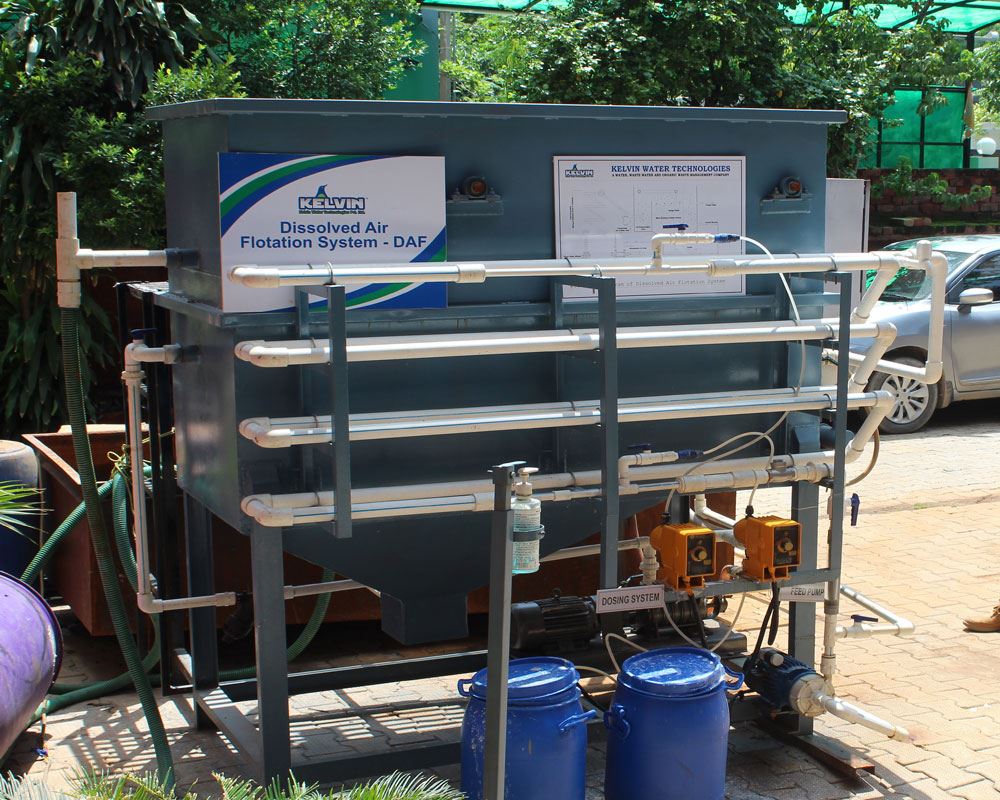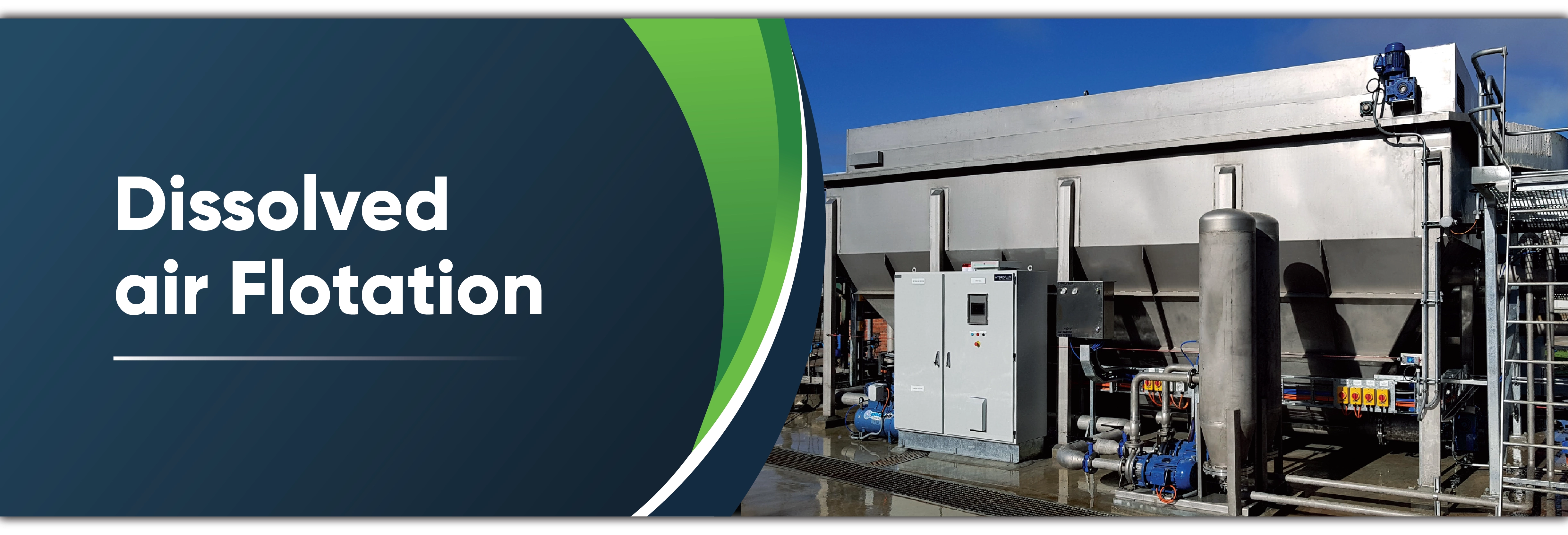DAF- Dissolved Air Flotation in Wastewater
DAF is a water & wastewater treatment system which remove contaminants like oil and suspended solids. In DAF system wastewater is treated by dissolving air in wastewater under pressure and then released at atmospheric pressure in a flotation tank basin. It is one of the most effective and versatile process in water treatment. Depending upon the type of filtration system DAF can be installed after pre-treatment or at initial. In some industries like oil & flammable gases, Dissolved Air Flotation Unit use nitrogen as medium because as compared to air, nitrogen has less risk of explosion.



Process Design of DAF System
-
Fine Screening- It is the removal of the heavy matter prior to flotation pretreatment process. It basically reduced load of basically non—floating, heavy solids going towards DAF. It is important to remove these heavy matters so they don’t block pumps and piping.
-
Equalization- It provides a constant & less variable load to the DAF system which improves the efficiency and quality of effluent. A sufficient amount if mixing is required to retention time to keep solids to settle and oil grease from collecting from the surface.
-
pH Control – Most flocculation’s and coagulation optimize pH range. Apart from this most wastewater treatment system requires a separate pH control system to maintain pH.
-
Flocculation Control – In many wastewater treatment system a unit is provided for addition of flocculants and coagulants to achieve the effective flocculation of contaminants prior to flotation.
Flow Diagram of DAF Unit

Process of DAF- Dissolved Air Flotation
Feed water is added to the DAF float tank or chemical mix tank in which small particles are formed into big particles by adding coagulant like ferric chloride and aluminum sulphate which coagulate the smaller particle to form cluster. Then the effluent water is pumped to the small vessel in which air pressure is maintained with the help of air compressor which helps in saturation of pressurized water with air. Waste water is recycled through recycling pumps passing through air compressor to air drum & then into float tank again.
Why DAF is used ?
-
Recovery & reuse of waste water
-
To meet desired parameters before discharging water.
-
Thickening of Biosolids
-
For better effluent quality & reduce load on ongoing biological treatment system
-
High removal efficiency & easy sludge thickening or removal
Features of Kelvin DAF Unit
Kelvin Water Technologies is a water & wastewater treatment company that is manufacturing & supplying water & wastewater treatment from last two decades. With continue R&D & multiple installation we have made a fully developed DAF system for a variety of application. Kelvin DAF unit provides unique features: -
-
Customized models available according size and type of application.
-
Prefabricated SS 304 Skid for long life and easy installation.
-
Circular or rectangular profile to utilize maximum space.
-
Extended retention time give better effluent quality.
-
Designed for low velocity to achieve better separation
-
Maximum & easy removal of sludge by thickening it.
-
Corrosion resistance
-
High temp & wide pH tolerance
Key Components of DAF System
-
Skimmer System
-
flotation Cell
-
Contact Chamber
-
Influent
-
Air Saturation System
-
Bottom Skimmer System
-
Float
-
Effluent Discharge Chamber
Dissolved Air Flotation System
DAF - FAQ
Q1. What is dissolved air flotation system?
Ans. DAF is the procedure of disposing of suspended solids, oils and other contaminants via the usage of air bubble flotation. Air is dissolved into water, combined with the waste circulate and launched from answer at the same time as in intimate touch with the contaminants.
Q2. Why do we use dissolved air flotation?
Ans. The dissolved air hastily carries solids and fats to the surface, without troubles with unpleasant odours and with an incredibly high performance of elimination. This permits a discount in pollutant load and subsequently within the dimensions of the whole set up.
Q3. Where is dissolved air flotation used?
Ans. It's usually used to deal with paper mill effluent, industrial wastewater, and wastewater generated via oil refineries, petrochemical and chemical plant life, and natural gasoline processing vegetation. Flotation is increasingly getting used to treat mineral and mining wastes.
Q4. What is the disadvantage of DAF water treatment?
Ans. A DAF is typically significantly greater compact than a traditional clarifier and produces a sludge fraction with a higher dry-count number content (2 - 4 %). The disadvantages of a flotation compared to a clarifier are the higher strength intake and the better unit fee.
Q5. What are the different types of DAF systems?
Ans. Three types of DAF. These are Micro Flotation, Vacuum Flotation & Pressure Flotation.
Q6. How does a DAF unit work?
Ans. DAF works by dissolving air beneath strain and then freeing hundreds of thousands of tiny air bubbles into the water at atmospheric pressure. This procedure permits the dissolved air bubbles to stick to a suspended be counted inside the water, inflicting it to return to the surface to be skimmed away.
Q7. What are the components of DAF system?
Ans. Generation of dissolved air flotation includes several additives like flotation tank (flotation), skimmer, feed distribution nicely, and back stress pump, valve, and saturation (the bubbles technology) device.
Q8. What is the flow rate of DAF?
Ans. This kind of flotation unit can be operated with go with the flow charges of water inside the range 25-40 m/l. Even a waft price of extra than 60 m/h has been mentioned from this form of DAF-devices. there's no hazard of clogging of the plate via suspended solids that could restriction the glide price.










